
If you can answer “no” to these questions, you can skip this blog post. Your supply chain is already a smooth-running machine. But if you answer “yes” to any of them, you may be making common supply chain errors that can dramatically increase transportation spending. Whether you are in exploration and production, transfer and storage, or refining, purifying, and marketing crude oil and natural gas products, here are some of the best places to look for your savings.
- Do your suppliers pay the shipping costs for your procurement material? Suppliers who ship product to you and bill you one price for the product plus transportation have no incentive to be economical in their choice of a carrier. Unbeknownst to you, some may even be marking up the cost of transportation. When you control your own inbound transportation, you know exactly what the transportation costs, and can build in efficiency and cost savings.
- Do you usually have short lead times (i.e., the time between placing an order and tendering the shipment to a carrier)? Sometimes, you really do need that shipment there in an hour. Consider using a hotshot if it will cost less for the transportation than it would to have the freight arrive too late to meet a critical deadline. Otherwise, remember that trying to tender a load within a week of a pickup increases the risk that the carrier you want has already committed their equipment to another shipper. MIT research shows that (1) loads with lead times longer than two days were the least likely to be rejected by carriers, and (2) the more lead time the carrier has between the tender and the pickup day, the more likely they are to accept the load. Research shows that savings can even be significant at the 48-hour mark.
- Do you use the same transportation method whenever you ship? At least consider other methods of shipping your products. There might be other options that cost less, depending on the transit times and service levels you need.
- Do you think it would be beneficial to know the carriers who transport your products? If you use a carrier you don’t know, and they end up in an accident—and if you don’t find out until then that they didn’t have insurance—you’re at risk. At a minimum, you should track that carriers have proof of the proper insurance levels and qualifications to haul your shipments.
- Do you use hotshots frequently? Hotshots charge significantly more than other types of transportation. They’re worth their weight in gold when you really need that load onsite within the hour. But it’s also quite possible that the only reason you need to expedite the delivery is because your supplier shipped it late. To save, limit the number of people who can hire a hotshot, and track the costs by supplier.
- Do your carriers wait too long to be loaded or unloaded? Carriers only get paid when their equipment is full and moving. Don’t make them wait. Set appointments for pickups and deliveries and get the carriers in and out as close to the schedule as possible.
- Do you carry excess inventory “just in case,” because you can’t depend on products arriving on time? Oil and gas deliveries often happen in remote areas. When you don’t know exactly how much inventory there is, you won’t know if you have enough on hand to satisfy projected demand. The result of that conundrum is usually holding significantly more inventory on hand than is needed. And that adds unnecessarily to your inventory carrying costs.
All of these questions also reveal the level of detail you need to know about transportation. Without this information, your supply chain is essentially invisible to you, and inefficiencies could be hiding in plain sight.



